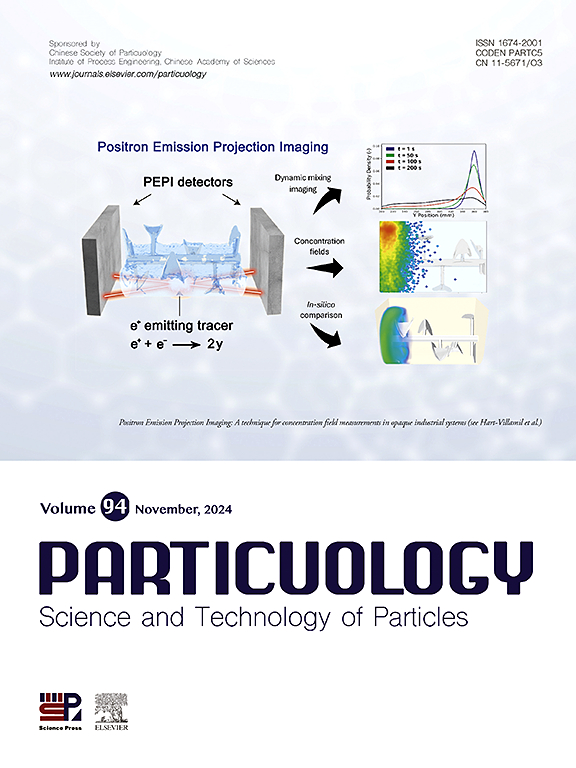Microdroplet cryo-crystallization for producing budesonide microparticles with optimized physicochemical properties
IF 4.3
2区 材料科学
Q2 ENGINEERING, CHEMICAL
引用次数: 0
Abstract
Inhalation therapies are pivotal for treating pulmonary diseases, yet their efficacy critically depends on the physicochemical properties of drug particles. This study introduces a novel microdroplet cryo-crystallization (MCC) technique to fabricate inhalable budesonide (BUD) particles. The MCC process combines rapid cryogenic freezing of drug-loaded microdroplets in liquid nitrogen, followed by additive-guided suspension crystallization in an anti-solvent environment. Cryogenic freezing suppresses molecular mobility and prevents aggregation, preserving uniform solute distribution. Subsequent controlled crystallization in the anti-solvent system enables precise tailoring of nanoparticle morphologies while avoiding supersaturation-driven amorphization. Systematic optimization identified MCC conditions yielding BUD ultrafine crystals with a volume median diameter of 3.0 μm, >94 % sphericity, >98 % crystallinity, and minimal hygroscopicity (<0.5 %). Compared to conventional air-jet milled BUD (∼90 % crystallinity and ∼3 % hygroscopicity), the MCC-engineered particles exhibit significantly improved physicochemical stability and dissolution performance (94 % in 180 min). The MCC strategy decouples cryogenic freezing and phase transformation, avoiding top-down limitations (e.g., milling-induced amorphization) and bottom-up issues (uncontrolled nucleation/aggregation) to achieve scalable and highly precise production of inhalable drug particles.

微滴冷冻结晶法制备物理化学性能最佳的布地奈德微粒
吸入疗法是治疗肺部疾病的关键,但其疗效严重依赖于药物颗粒的物理化学性质。介绍了一种新型的微滴冷冻结晶(MCC)技术制备可吸入布地奈德(BUD)颗粒。MCC工艺结合了载药微滴在液氮中快速低温冷冻,然后在抗溶剂环境中添加剂引导悬浮结晶。低温冷冻抑制分子迁移,防止聚集,保持溶质均匀分布。随后在反溶剂系统中控制结晶,可以精确剪裁纳米颗粒形态,同时避免过饱和驱动的非晶化。系统优化确定了MCC条件下产生的BUD超细晶体的体积中值直径为3.0 μm,球形度为94%,结晶度为98%,吸湿性最小(0.5%)。与传统的喷气研磨BUD(~ 90%结晶度和~ 3%吸湿性)相比,mcc工程颗粒表现出显着改善的物理化学稳定性和溶解性能(180分钟内溶解94%)。MCC策略将低温冷冻和相变解耦,避免了自上而下的限制(如研磨引起的非晶化)和自下而上的问题(不受控制的成核/聚集),以实现可吸入药物颗粒的可扩展和高精度生产。
本文章由计算机程序翻译,如有差异,请以英文原文为准。
求助全文
约1分钟内获得全文
求助全文
来源期刊

Particuology
工程技术-材料科学:综合
CiteScore
6.70
自引率
2.90%
发文量
1730
审稿时长
32 days
期刊介绍:
The word ‘particuology’ was coined to parallel the discipline for the science and technology of particles.
Particuology is an interdisciplinary journal that publishes frontier research articles and critical reviews on the discovery, formulation and engineering of particulate materials, processes and systems. It especially welcomes contributions utilising advanced theoretical, modelling and measurement methods to enable the discovery and creation of new particulate materials, and the manufacturing of functional particulate-based products, such as sensors.
Papers are handled by Thematic Editors who oversee contributions from specific subject fields. These fields are classified into: Particle Synthesis and Modification; Particle Characterization and Measurement; Granular Systems and Bulk Solids Technology; Fluidization and Particle-Fluid Systems; Aerosols; and Applications of Particle Technology.
Key topics concerning the creation and processing of particulates include:
-Modelling and simulation of particle formation, collective behaviour of particles and systems for particle production over a broad spectrum of length scales
-Mining of experimental data for particle synthesis and surface properties to facilitate the creation of new materials and processes
-Particle design and preparation including controlled response and sensing functionalities in formation, delivery systems and biological systems, etc.
-Experimental and computational methods for visualization and analysis of particulate system.
These topics are broadly relevant to the production of materials, pharmaceuticals and food, and to the conversion of energy resources to fuels and protection of the environment.
 求助内容:
求助内容: 应助结果提醒方式:
应助结果提醒方式:


